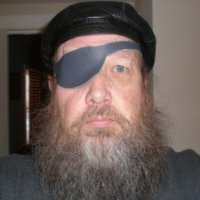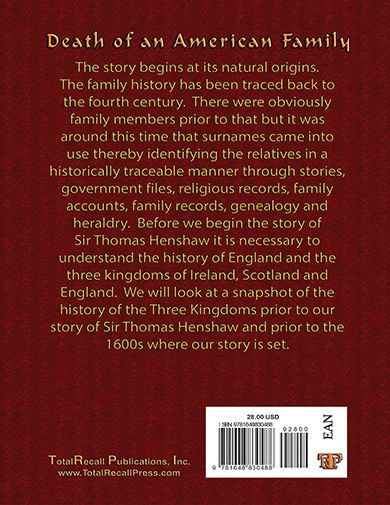Non Fiction
Four Generations: The Death of an American Family; The Beginning
World History
General Historical Background of the Three Kingdoms
100 BC to 1066 AD to 1276 AD to Present
The United Kingdom of the current day has a rich history. There is evidence of settlement as far back as 700,000 BC. It was under constant settlement from the Bronze Age. It was invaded multiple times over the early years depositing diverse gene pools and cultural, religious and ethnic backgrounds in the area.
It had various names. In the early ages it was known as Albion. Later it was called Britannia and then England and Great Britain. It is now part of the United Kingdom reflecting the joining of the Kingdoms of England, Ireland and Scotland under one government
Early settlements were of warrior clans or invaders and this like many things I have discovered in my family history and current events set a pattern that would simply be repeated from that time and most likely into the future.
Celts and Britons
During the Bronze Age (700 to 400 BC) the British Isles were populated by the Celts along with western and central Europe. The Celts were also in Ireland and Asia Minor. They ruled the area prior to the Roman period. The Celts were called many names:
To the Greeks—Keltoi, To the Romans—Gauls or Galli Gauls: France, Galicia: Spain, Galatians
The Celts were split into tribes and never became an empire. In Scotland and Ireland they were called clans. Below are some of the known names.
Names of some of the Celtic Tribes/Clans in Britain/Ireland/ Scotland:
Caledonii, Boresti, (Northern Scotland); Damonii, Novantae, Selgovae, Votadini (Southern Scotland); Carvetii, Brigantes, Parisi--old Gauls (Cumbria, Yorkshire, Durham & Lancashire);
Deceangli/Ceangi (north coastal area of Wales), Ordovices, Silures, Demetae (Wales); Cornovii, (Staffordshire, Shropshire, Cheshire); Celts: Well established tribes, but never joined together to form an empire: Corieltauvi/Coritani (Lincolnshire, Leicestershire, Nottinghamshire, Derbyshire, Northhamptonshire); Dobunni (Cotswolds); Durotriges (Dorset, parts of Wiltshire & Somerset); Dumnonii (south west peninsula--Chysauster & Carn Euny); Iceni, Catuvellauni, Trinovantes--north of the Thames--& Cantiaci (Norforlk, Essex, Sulfolk, Cambridgeshire, London, Hertfordshire, Bedfordshire, Oxfordshire, probably Buckinghamshire, & Canterbury);
Atrebates--associated with the Gauls & pro-Roman--(Sussex, Hampshire, Berkshire, West Surrey, north east Wiltshire); Regnenses/Regni (also Sussex; Hampshire); Cantium (Kent, part of Sussex); Belgae--migrated from Belgium? (Winchester, Bath).
Britons and Roman Britons
The Roman Empire became interested in the Islands around 300 to 400 BC. Aristotle had used the term “Albion” to describe the area and this is what it was known as during this time. The Romans were aware of the large tin deposits on these lands and deemed it to be worth their interest around 55 BC. Rome had a passing interest until around 31 AD when they returned to conquer the area and bring it into the Roman Empire.
The Britons, under Roman rule, formed into the Roman Britons and emerged onto this time. This period lasted from 78 to 441 AD. The Islands were now known as “Brittania” and it became one of the forty-five provinces of the Roman Empire. During the Roman times there were many improvements made to the areas infrastructure such as roads, buildings, cathedrals and baths.
Many of their methods of transportation, manufacturing, farming and culture were absorbed by those living through the times.
Anglo-Saxons
The next invaders were the Angles. Described as a Germanic Tribe they combined forces with the Jutes and the Saxons to invade England in force in the 5th century AD. Their invasions began during the Roman occupation around 376 to 441 AD through around 800 AD.
The current name of “England” came from these people who spoke a language called “Englisc”. There was a mass migration of these people from northern Germany that settled the area. This in turn caused a migration of the Britons/Roman Britons into the mountains or the Brittany and were now called Bretons or Roman Bretons.
The Anglo Saxon period is considered to be roughly 400 to 800 AD. They were savage warriors. According to Winston Churchill in his writings he described them as thus "The invaders themselves were not without their yearnings for settled security.
The Saxon was moreover a valley-settler. His notion of an economic holding was a meadow for hay near the stream, the lower slopes under the plough, the upper slopes kept for pasture". The Saxons that settled into the area were known as the ‘Old Saxons’ to distinguish them from the Saxons on the European continent that had stayed behind much like the English who came to the new world became Americans. The evolution of the Anglo Saxon was complete when their designation changed after the Norman Conquest and Anglo-Saxon simply came to designate the term English. Many believe that this migration is the starting place for the Henshaw Family on the Islands.
Vikings & Anglo-Normans
The remains of a Viking Ship which conducted raids on The Three Kingdoms
Around 789 AD the Vikings began to raid. These raids came in earnest around 835 AD. They ruled the area for two hundred and fifty years. The Vikings were seaman and warriors from Norway, Denmark and Sweden. The Vikings settled in England and France. The Vikings used the ancient Runic (Futhark) alphabet made up of symbols and was deemed ‘Magical Writing’.
These groups that settled in England and particularly in France (Normandy) were called Normans. It was a derivation of Norsemen meaning men of the north. These Normans, especially those that settled in France, were made up of the remnants of other invaders including the Vikings, Saxons, and old Roman Bretons. The group in France was considered more advanced and culturally developed than the group that settled in England. The French group had developed their own dialect and customs. The Germanic and Scandinavian based Normans came back across the channel and invaded the Saxons in 1066 AD. These Normans now became the new English Aristocracy.
Modern English was a mixture of Old English and Anglo-Norman. (“Old English” was Saxon-low German; "Anglo-Norman" was Scandinavian and Romanic--a Roman Latin and Germanic blend.)
As this history is described one thing becomes apparent. From the earliest times the area, like most populated areas of this age, was under a state of constant conflict from one enemy or another. Several cultures acclimated to the area and when they were driven out some of the soldiers and civilians stayed behind and settled into the land. Indeed, the people that we now know and the people of the sixteenth century were undoubtedly of a bloodline from one or many of these conquerors or invaders that came into the area and failed to leave.
Family History
Henshaws before the use of Surnames
Surnames were a product of a time when populations in certain areas began to expand to the point that there needed to be a designation to identify individuals using the same name within a particular region. For example, the name William would have been easy to remember. But it was a popular name and many families named their children William. Indeed, in some families, two to three generations of sons could have been named William within the same household----thus William I, William II, William III, etc was a designation developed to specify the specific individual. When the names were not in the same family but within a community or region---surnames were developed. Early names such as William the Red, for example, could be used for the William who had red hair. Eventually surnames developed such as Williamson for the son of William or Stratford for being from the area near the ford across a particular river or stream. In the times before this we indeed and obviously had family members. Some were not identified in a distinct enough manner to enable us to track them through existing records or history. It is likely that some or all of the bloodlines listed above run through the family itself. In a visit to a small Heraldry shop in the Shambles, an older section of York, England, I was told by the proprietor, when we found our Scottish Coat of Arms, that the family almost definitely had Viking blood from earlier times. Indeed, there exists a family name in the Scandinavian Countries of Hanshus which translated means the same as Henshaw in English. Upon further investigation it is clear that Viking strongholds were established in the area around Liverpool where our family history begins adding credence to this idea. With this information, we go forward, rather than backwards, as our detective work would not be fruitful beyond this period. We know that the first Coat of Arms was issued to a William Henshaw in 936 AD. He was described as a gentleman of wealth and influence. There is another entry of Arms on December 20, 1565 during the reign of Elizabeth I. A further entry during the reign of James I stated that the arms had been restored to Thomas Henshaw of Toxteth Park and that he was knighted. This search into the past beyond Sir Thomas Henshaw could be done at a later time to endeavor to put some of the earlier pieces into place and would start with an examination of the Hanshus.
It should be noted that Arms were awarded to an individual and not the family. There were rules of passing and who could wear the arms. Usually different branches of a family would alter the arms in simple ways to identify each branch. The Henshaw Families chose not to `alter the arms and they were kept and worn identically by each branch. Because of fraud in the wearing of arms in the time of James I a heraldry commission was established whose mission was to certify and approve each set of arms in use. Sir Thomas Henshaw was certified from the commission as the proper wearer of the arms. Sir Thomas was personally knighted by the King.
Some Examples of the English Coat of Arms
A REPORT ON RESEARCH
IN THE OFFICIAL RECORDS
OF HER MAJESTY'S COLLEGE OF ARMS
Prepared by
H. E. Paston-Bedingfeld Esq.
Rouge Croix Pursuivant of Arms
The College of Arms
Queen Victoria Street
London EC4V 4BT
14th October 1988
Dear Mr. Hinshaw,
I write to give you my report on research carried out amongst our Official Records of the College of Arms for the name and Arms of Hinshaw/Henshaw and variants.
Research amongst our Official Records of Grants of Arms, made by the English King of Arms from approximately 1530 until 1880, produced no references for Hinshaw, but two for variant spellings as follows:
1) Misc. Grants VIII-47.
This refers to the Confirmation to John Heynshaw of Chichester in 1565 of the following Arms and Crest:
Arms: Quarterly Argent and Azure a cross charged wth [sic] five crescents all countercharged in the dexter chief and sinister base a dolphin embowed of the first.
Crest: A griffin's head couped per pale Argent and Azure charged on the neck with three bars countercharged, in the beak an olive branch Vert, fructed Or.
2) Grants 2-657. This was a grant to Thomas Henshawe of London son of Robert Henshawe of Prestbury in Chester son of Edward of the same county of the following Arms and Crest:
Arms: Argent a chevron Ermine between three Moore cocks Sable beaked and legged Gules.
Crest: A falcon seasing on a wing Gold with a crown about the neck Gules beak and legs Sable with bells of the first.
The above Armrial [sic] Bearings were granted on 26 June 1611 and were to be borne by Thomas Henshawe and his descendants.
A separate series of Grants made since 1800 was checked for Hinshaw but without result.
Our official Records of the Herald's Visitations were then examined. These records cover the period between 1530 and 1686 and were compiled by the heralds as they visited each county checking that the Arms being used by the gentry were correct and also recording their pedigrees. Once again I was unable to find any entries for Hinshaw but the following were found for Henshaw(e):-
1) C21-14 (Essex 1634). This entry shows a three-generation pedigree headed by Thomas Henshawe of London who died 11th January 1611. He had three sons, Nathaniell, Benjamin and Thomas. The Arms shown with this entry are similar to those in Grants 2-657.
2) C27-18b (Sussex 1634). A four-generation pedigree headed by Thomas Henshaw, who had sons Thomas, William, Michael and Edward. No issue is shown for William and no mention is made of any members of the family having emigrated to Ireland.
3) C38-44b (Chesshire 1663). A six-generation pedigree of Henshaw of Henshaw, headed by Thomas Henshaw of Henshaw. His grandson Thomas is described as "Thomas Henshaw of Henshaw a Captain in Ireland. Slaine there.". This Thomas is shown as having a son Lea who died in 1661. This Lea is not described as Thomas's only son, so there could have been others. The arms depicted are slightly different - Argent a chevron between three birds Sable beaked and legged Gules.
For the next phase of research our Official Pedigrees, placed upon official record since the end of the Visitation period were examined and the following pedigrees found:
1) NII-141. A three-generation pedigree headed by Benjamin Henshaw of Dorset who died in 1631.
2) NXII-74. A two-generation pedigree (connected to NII) headed by Thomas Henshaw who was Envoy Extraordinary to Christian V, King of Denmark, and was born in 1618. No arms are shown for Henshaw.
3) NXIII-12. A two-generation pedigree headed by Charles Henshaw of London.
4) 14 D14-255. This entry shows a six-generation pedigree headed by Thomas Henshaw eldest son of William Henshaw, whose own son William died in 1676. Arms are as in Grants 46 (Fraser Bradshaw Smith appears on this pedigree).
Our Irish Records were then consulted and an entry found for Hinshaw. This entry concerns a narrative pedigree contained in the Visitation of Ireland 1607 and which shows the marriage of Nicholas Welsh of Dondrumme to Ursula daughter of Captain Hinshaw of Hinshaw Hall. No arms are shown.
As I expect you realise, in order to bear Arms legally, one has to be able to prove legitimate descent in the male line from an ancestor who was legally granted or allowed Arms in the past, and to place the proven pedigree upon official record here at the College of Arms. In order for you to legally bear and use any of the coats of arms referred to in my report you would need to prove such a descent from the grantee in the case of Grants references or from the person heading the pedigree in Visitation references.
It would be possible to provide you with a painting, for display purposes, of any of the coats of arms described in my report for which I would be pleased to obtain a quotation. Such a painting, commissioned from one of our own heraldic artists, would be of the highest standard of heraldic art.
I hope that the information I have given os [sic] of interest, although I am sorry not to have been able to find any references amongst our pedigrees relating to Hinshaws having emigrated to America.
Yours sincerely,
Mrs. B. Pendley
Assistant to Rouge Croix Pursuivant of Arms.
Some Henshaw Family History
Family History: History of the Henshaw, Hinshaw, Hanshaw Surname
Origin: According to the Deliquest’s “Three Names of Ours”, Hinshaw, Henshaw and Hanshaw are believed to be a variant of Hernshaw, and signifies “ancient wood” derived from the Old English “Hen”, meaning “Old or Ancient”, and “Shaw” meaning “a Wood”. The name Hernshaw is abbreviated from Heronshaw; a woodland abounding in herons, or a heronry where long-legged wading birds were bred. Henshaw is also a local or place name derived from a locality in County Chester, England by the name of Henshaw.
From Bardsley’s “English and Welsh Surnames” we learn that a “Shaw or Schaw” was a small woody shade or covert. As a shelter for game and the wilder animals, it is found in such compounds as Bagshaw, Hindshaw, Ramshaw, Henshaw and Earnshaw.
Below are other spellings and their likely origins
Hensha found in the records of Joshua Henshaw in Dorchester MA after abduction by Peter Ambrose and Robert Mathers.
Hinchy/Henchy found in various records in Ireland
Henschaw Various spellings of the name using the ending “Schaw”
Hinschaw Various spellings of the name using the ending “Schaw”
Hanschaw Various spellings of the name using the ending “Schaw”
Hinshaw- considered a spelling error which would reverse itself on different records. There is a story that it was from the family who settled in Northern Ireland and a product of the Irish lilt in speaking the name
Henshawe Other radical spellings considered errors in transcription of spelling
Hineshaw Other radical spellings considered errors in transcription of spelling
Hindshaw Other radical spellings considered errors in transcription of spelling
Hanshaw Other radical spellings considered errors in transcription of spelling
Hincher Other radical spellings considered errors in transcription of spelling
Hinshall Other radical spellings considered errors in transcription of spelling
Henshall Other radical spellings considered errors in transcription of spelling
Hinchow derived from a gravestone in Franklin Co. TN. The deceased lady pronounced her name Henshaw.
Hofinchel A spelling appearing in the Domesday Book
Hanshus Variations of the name from the Norsemen or Saxons
Hansus Variations of the name from the Norsemen or Saxons
Hanshaw Other radical spellings considered errors in transcription of spelling
Hingeshaw from research of Wade Henshaw of Celtic origins and meaning “Dweller at or near a tree grove frequented by wild birds. The bird would be the Moorhen or its other name Heronshaw.
Hernshaw same as Hingeshaw
Heronshaw same as Hingeshaw
Heronshawe same as Hingeshaw



